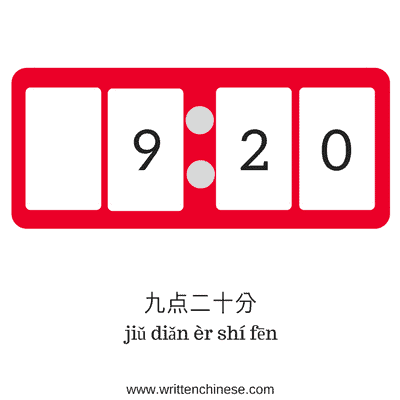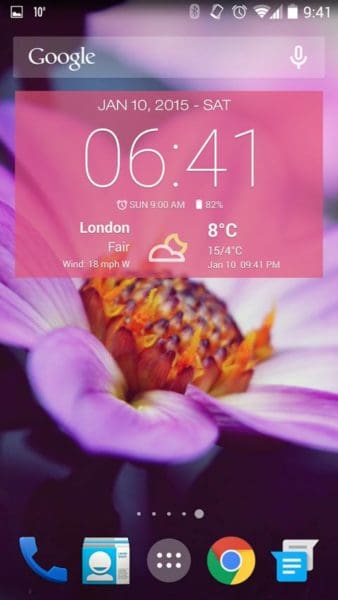Knowing how to tell the time is pretty essential if you want to make plans with your Chinese friends or want to catch a flight on time. We’ve given you a super simple guide for telling the time in Chinese, and how to talk about the days of the week, month of the year and even today’s date.
Hours
Time in Chinese is measured in hours 小时 (xiǎo shí), minutes 分 (fēn) and seconds 秒 (miǎo).
When referring to an amount of hours we use the measure word 个 (gè):
#个 (gè) + 小时 (xiǎo shí)
一个小时 (yī gè xiǎo shí) – 1 hour
两个小时 (liǎng gè xiǎo shí) – 2 hours
When counting in Chinese, the number 2 is not 二 (èr), but 两 (liǎng).
Half an hour is 半 (bàn), which comes in place of the number:
半个小时 (bàn ge xiǎo shí) – half an hour
To combine hours and half hours place the number of hours first, then the half hour:
#个 (gè) + 半 (bàn) + 小时 (xiǎo shí)
三个半小时 (sān gè bàn xiǎo shí) – 3 and a half hours
Minutes and Seconds
When telling the time, a phrase indicating how many minutes or seconds can end in the noun 钟 (zhōng), meaning clock.
四分钟 (sì fēn zhōng) – four minutes
五秒钟 (wǔ miǎo zhōng) – 5 seconds
Halves can also be added here after 分 (fēn):
一分半 (yī fēn bàn) – one and a half minutes
三秒半 (sān miǎo bàn) – three and a half seconds
Telling the Time

Expressing time on the hour uses the character 点 (diǎn) meaning ‘dot’. Often, the word for clock, 钟 (zhōng), can be omitted.
Hour + 点 (diǎn) (钟) (zhōng)
六点钟 (liù diǎn zhōng) – six o’clock
八点钟 (bā diǎn zhōng) – eight o’clock

It is common to speak the time, as you read it on a digital clock:
九点二十分(钟) (jiǔ diǎn èr shí fēn (zhōng)) – 9:25
The character 钟 (zhōng), is implied within the sentence and does not need to be used.
If the minutes number is lower than 10, then you may use the word for zero, 零 (líng):
五点零七分 (wǔ diǎn líng qī fēn) – 5:07
To express ‘a quarter past’, use 一刻 (yī kè), and for ‘three quarters past’, use 三刻 (sān kè).
四点一刻 (sì diǎn yī kè) – 4:15
八点三刻 (bā diǎn yī kè) – 8:45
Specific Time
To refer to a specific time past the hour, the character 过 (guò) is used, meaning ‘spent’:
Hour + 点 (diǎn) + 过 (guò) + minutes + 分 (fēn)
十点过十分(钟) (shí diǎn guò shí fēn (zhōng)) – 10:10
八点过四十分 (bā diǎn guò sì shí fēn) – 8:40
差 (chà) can be used to refer to minutes before the hour:
Hour + 点 (diǎn) + 差 (chà) + minutes + 分 (fēn)
六点差二十分 (liù diǎn chà èr shí fēn) – 5:40
十一点差五分 (shí yī diǎn chà wǔ fēn) – 10:55
AM/PM
Time of day is indicated with various time phrases in the place of AM and PM. They are always used before the actual time is given.
早上 (zǎo shang) – morning
上午 (shàng wǔ) – before noon
中午 (zhōng wǔ) – midday
下午 (xià wǔ) – afternoon
晚上 (wǎn shang) – evening
半夜 (bàn yè) – midnight/ early hours of the morning
晚上六点半 (wǎn shang liù diǎn bàn) – six thirty in the evening
早上八点钟 (zǎo shang bā diǎn zhōng) – eight in the morning
Clock time phrases always come after the subject at the beginning of the predicate.
他每天晚上七点去外面跑步。(tā měi tiān wǎn shang qī diǎn qù wài mian pǎo bù)
Every evening at 7pm he goes out for a run.
Asking the Time
现在几点钟?(xiàn zài jǐ diǎn zhōng) – What time is it?
The Chinese Calendar
There are two different calendars in use in China, the Western calendar, and the Agricultural calendar, which marks traditional Chinese festivals revolving around the moon and the solstices.
Years in Chinese are expressed with the character 年 (nián). Just add 年 (nián) after the year:
三年 (sān nián) 3 years
To ask how many years, use the phrase 几年? (jǐ nián) or 多少年 (duō shao nián?
Referring to Years
今年 (jīn nián) – this year
明年 (míng nián) – next year
后年 (hòu nián) – two years from now
大后年 (dà hòu nián) – three years from now
去年 (qù nián) – last year
前年 (qián nián) – the year before last
大前年 (dà qián nián) – three years ago
Saying the Year
A year is read in single numbers followed by 年 (nián):
一九八七年 (yī jiǔ bā qī nián) – 1987
Talking about years
哪年?(nǎ nián) – Which year?
你是哪年毕业的?(nǐ shì nǎ nián bì yè de?) – Which year did you graduate?
Months
月 (yuè) is the character that refers to months in Chinese, and is also used when referring to a specific month’s name. The measure word for a month is 个 (gè) . To count months just add the classifier after the number, followed by 月 (yuè).
两个月 (liǎng gè yuè) – two months
五个月 (wǔ gè yuè) – five months
To ask ‘How many months?’ use the phrase:
几个月?(jǐ ge yuè)
or
多少个月? (duō shao gè yuè)
你已经学了多少月了? (nǐ yǐ jīng xué le duō shao yuè le?) – How many months have you studied for?
这个月 (zhè gè yuè) – this month
下个月 (xià gè yuè) – next month
上个月 (shàng gè yuè) – last month
Names of the Months

一月 (yī yuè) – January
二月 (èr yuè) – February
三月 (sān yuè) – March
四月 (sì yuè) – April
五月 (wǔ yuè) – May
六月 (liù yuè) – June
七月 (qī yuè) – July
八月 (bā yuè) – August
九月 (jiǔ yuè) – September
十月 (shí yuè) – October
十一月 (shí yī yuè) – November
十二月 (shí èr yuè) – December
几月?(jǐ yuè) – Which month?
你是几月生的? (nǐ shì jǐ yuè shēng de) – In which month were you born?
Dates on the calendar
The date is referred to with the 号 (hào) character. To talk about a specific day of the month, add 号 (hào) after the number:
二十七号 (èr shí qī hào) – 27th (of the month)
二十二号 (èr shí èr hào) – 22nd (of the month)
To ask for the date use the following sentences:
几号?(jǐ hào) What is the date?
Or
多少号?(duō shao hào) What is the date?
Or
今天几号?(jīn tiān jǐ hào) What is today’s date?
Weeks
A week is usually expressed with the bigram 星期 (xīng qī) or the character 周 (zhōu).
Weeks are counted using the measure word 个 (gè):
一个星期 (yī gè xīng qī) – one week
几个星期?(jǐ ge xīng qī) – how many weeks?
这个星期 (zhè gexīng qī) – this week
下个星期 (xià gè xīng qī) – next week
上个星期 (shàng gè xīng qī) – last week
Weekends are referred to with the bigram 周末 (zhōu mò).
这个周末 (zhè ge zhōu mò) – this weekend
下个周末 (xià gè zhōu mò) – next weekend
上个周末 (shàng gè zhōu mò) – last weekend
Days
There is no measure word for days, and the number of days is followed by 天 (tiān), the character for day.
六天 (liù tiān) – 6 days
八天 (bā tiān) – 8 days
几天? (jǐ tiān) – how many days?
Or
多少天?(duō shao tiān) – how many days?
Days of the Week
星期一 (xīng qī yī) / 周一 (zhōu yī) – Monday
星期二 (xīng qī èr) / 周二 (zhōu èr) – Tuesday
星期三 (xīng qī sān) / 周三 (zhōu sān) – Wednesday
星期四 (xīng qī sì) / 周四 (zhōu sì) – Thursday
星期五 (xīng qī wǔ) / 周五 (zhōu wǔ) – Friday
星期六 (xīng qī liù) / 周六 (zhōu liù) – Saturday
星期天 (xīng qī tiān) / 周日 (zhōu rì) – Sunday
星期几?(xīng qī jǐ) – which day of the week?
Or
周几?(zhōu jǐ) – which day of the week?
今天 (jīn tiān) – today
昨天 (zuó tiān) – yesterday
明天 (míng tiān) – tomorrow
后天 (hòu tiān) – the day after tomorrow
大后天 (dà hòu tiān) – three days from now
前天 (qián tiān) – the day before yesterday
大前天 (dà qián tiān) – three days ago
Dates

When speaking or writing the date in Chinese, we begin with the largest unit first down to the smallest unit.
Year + month + date
一九九五年八月十六号 (yī jiǔ wǔ nián bā yuè shí liù hào) 16th August 2015
Exercises
Share you answers with us below and check them on our Q&As That Will Help You Make Chinese Friends.
Translate the following sentences into Chinese:
1a. How long will this movie be?
1b. One hour and forty minute.
2. He planned to go swimming in the morning.
3. Translate the date and time from the image below into Chinese:

Post your answers below, and we’ll check them for you! We’ll post the answers below soon.
